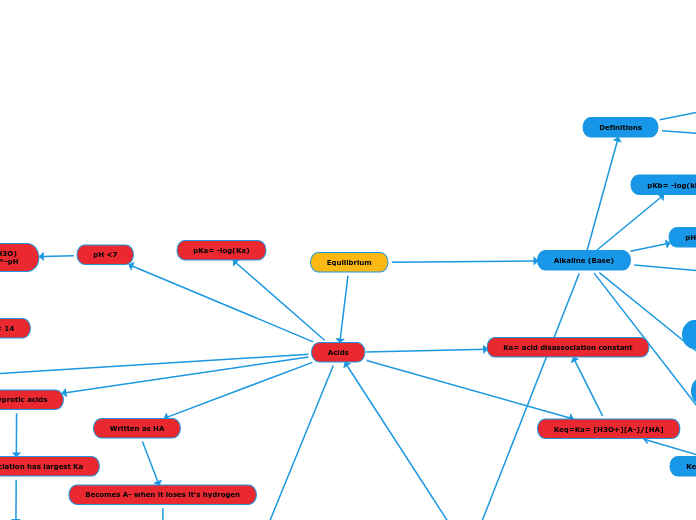Equilibrium
Alkaline (Base)
Strong bases
Alkali metal hydroxides
(Group one)
Highly soluble in water and high pH
Alkali metal hydroxides
(Group two) Though they have low Ksp
Lower pH and smaller Ksp
[OH-]= 10^-pOH
pOH= -log[Oh-]
Conjugate pairs
Connects acids and bases through the gain and loss of a proton
Ex: H2CO3 → HCO3
Ka*Kb=Kw=10^-14
pKa+pKb at 25 degrees = 14
Stronger acid = weaker conjugate base
Stronger conjugate base = weaker conjugate acid
pH >7
Keq=Kb=[BH+][OH-]/[BOH]
Kb = base disassociation constant
Keq
Affected by delta H and temperature
When Keq>1, the forward reaction is favored
When Keq<1, the reverse reaction is favored
Kf/Kr
[C]^c[D]^d/[A]^a[B]^b
Ice tables(concentrations at EQ)
Used to solve for x, using stoichiometry.
phase equilibrium
When [P] and [R] stabilize, equilibrium is reached
Easier in a closed system
Dynamic equilibrium
Forward and reverse actions are constant
Reactions re reversible
Le chatelier's principle
When conditions change, eq is changed
Ex: changed in pressure, temperature are counteracted
Temperature speeds up forward and reverse reactions
Pressure lowers, concentration lowers
Ex: gas exchange in the lungs
Due to large amounts of H2O already present, we ignore H2O in Keq expressions, as it will not greatly impact the outcome of concentration.
Ksp
Higher ksp= more soluble
Used on highly insoluble salts
Crystallization of cations and anions.
Dissolution of salt crystals
common ion effect
At Eq, solids stop dissolving
sped up by larger surface area= faster to eq
Hard vs soft water
Kidney stones
Acids
pKa= -log(Ka)
Types
Strong acids
100% disassociation
Ex: HCl, HBr, HI
Weak acids
Can calculate %disassociation... often 1%
pH <7
pH= -log(H3O)
(H3O)=10^-pH
pH+pOH= 14
Keq=Ka= [H3O+][A-]/[HA]
Ka= acid disassociation constant
polyprotic acids
First disassociation has largest Ka
Next disassociation progressively has smaller Ka
Written as HA
Becomes A- when it loses it's hydrogen
Ha+H2O→H3O+ + A-
Acid base titrations
(Weak acid in this example)
Before base is added
Disassociation of weak acid in H2O
Before equivalence point
Excess weak acid
at equivalence point
Weak acid is neutralized, turns into a conjugate base
After equivalence point
Intial [OH-] from excess base
Used to find amounts of acid in a solution through neutralization
ph indicators
If done correctly, the ph indicator will change colour at the equivalence point. If not, it may change too soon, leaving the equivalence point unsolved for.
n acid=n base
CaVa=CbVb
Solution is neutral when this has been achieved
Buffer system
Used to stabilize the pH of a solution
Must require an acid base conjugate pair
pH = pKa of weak acid
Acid added neutralizes the conjugate pair base
Base added neutralized the conjugate pair acid
